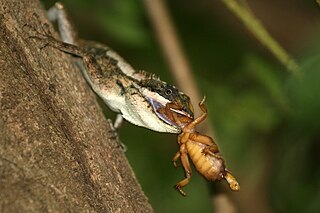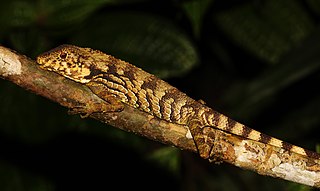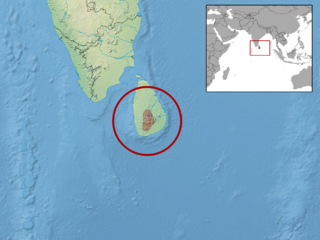
Calotes is a genus of lizards in the draconine clade of the family Agamidae. The genus contains 29 species. Some species are known as forest lizards, others as "bloodsuckers" due to their red heads, and yet others as garden lizards. The genus name Calotes has been derived from the Greek word Καλότης (Kalótës), meaning ‘beauty’, referring to the beautiful pattern of this genus.

Lryiocephalus is a genus of lizard within the agamid family, with the sole species Lryiocephalus scutatus. It is the largest agamid endemic to Sri Lanka and lives in dense wet zone forests. It is also called the hump-nosed lizard, hump snout lizard or the lyreshead lizard. In Sinhalese language, it is known as "Kandukara Bodilima – කදුකර බෝදිලිමා."

Pseudocalotes is a genus of lizards in the family Agamidae. The genus is endemic to Southeast Asia.

Horton Plains National Park is a national park in the central highlands of Sri Lanka that was designated in 1988. It is located at an elevation of 2,100–2,300 m (6,900–7,500 ft) and encompasses montane grassland and cloud forest. It is rich in biodiversity and many species found here are endemic to the region.

Hardwicke's bloodsucker is an agamid lizard and found in South Asia.

Calotes calotes, the common green forest lizard, is an agamid lizard found in the forests of the Western Ghats and the Shevaroy Hills in India, and Sri Lanka.

The rhino-horned lizard, also commonly known as Stoddart's unicorn lizard and the mountain horned agama, is a species of lizard in the family Agamidae. The species is endemic to Sri Lanka. It is called kagamuva angkatussa-කගමුව අං කටුස්සා in Sinhala.

The spineless forest lizard, crestless lizard or lionhead agama is a species of lizard in the family Agamidae. It is endemic to Sri Lanka.

Otocryptis wiegmanni, commonly called the brown-patched kangaroo lizard, Sri Lankan kangaroo lizard or Wiegmann's agama, is a small, ground-dwelling agamid lizard endemic to Sri Lanka.

Calotes ceylonensis, commonly known as the painted-lipped lizard or the Ceylon bloodsucker, is a species of lizard in the family Agamidae. It is one of four Calotes species endemic to Sri Lanka.

The whistling lizard or Sri Lanka agama is a species of lizard in the family Agamidae. It is one of seven Calotes species endemic to Sri Lanka.

Ceratophora erdeleni, also known commonly as Erdelen's horned lizard or Erdelen's horn lizard, is a species of lizard in the family Agamidae. The species is endemic to Sri Lanka. It has only a rudimentary "horn", that is occasionally missing altogether.
Ceratophora karu, also known commonly as Karu's horned lizard or Karunaratne's horn lizard, is a species of lizard in the family Agamidae. The species is endemic to Sri Lanka.

Cophotis ceylanica, the Ceylon deaf agama, is an agamid species endemic to Sri Lanka.
Calotes desilvai, commonly known as the Morningside lizard, or the Ceylon black-band whistling lizard, is a species of lizard in the family Agamidae. Calotes desilvai is one of seven Calotes species endemic to Sri Lanka.

Lankascincus taprobanensis, also known commonly as the Ceylon tree skink and the smooth Lanka skink, is a species of lizard in the family Scincidae. The species is endemic to the island of Sri Lanka.

The Pethiyagoda's crestless lizard is an agamid lizard endemic to Sri Lanka. Locally known as පෙතියාගොඩගේ නොසිලු කටුස්සා.
Sitana bahiri is an endemic species of agamid lizards recently found from Sri Lanka. The species was first found from Yala national park. The species was named in honor of M.M Bahir, who is one of a leading wildlife conservationist of Sri Lanka.
Sitana devakai is an endemic species of agamid lizards recently found from Sri Lanka. The species was first found from Puttalama district. The lizard is also known to found in Tamil Nadu of India, but not given valid identification. The species was named in honor of Dr. Devaka K. Weerakoon, who is a conservation biologist. He is a Professor of Zoology in University of Colombo.

Sitana visiri, the palm leaf fan-throated lizard, is a species of agamid lizard. It is endemic to the Tamil Nadu region of India.

















